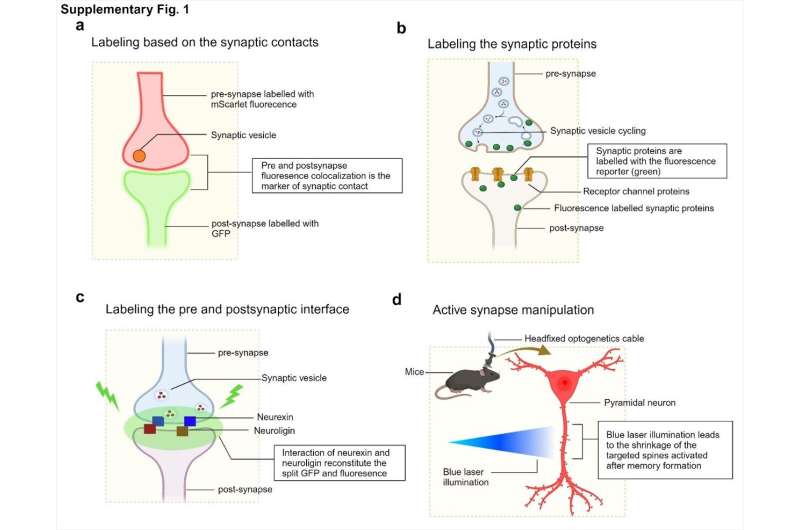This article has been reviewed according to Science X's editorial process and policies. Editors have highlighted the following attributes while ensuring the content's credibility:
fact-checked
peer-reviewed publication
trusted source
proofread
Exploring the frontiers of synaptic research with genetically encoded fluorescent tools

A review highlighting recent advances in genetically encoded fluorescent tools for labeling and selectively manipulating synapses has been published in Nature Reviews Neuroscience.
This innovative review was led by Director Kaang Bong-Kiun, Research Fellow Lee Sangkyu, and Postdoctoral Researcher Binod Timalsina from the Center for Cognition and Sociality (CCS) at the Institute for Basic Science (IBS) in Daejeon, South Korea.
Director Kaang is a pioneering scientist who has made significant contributions to studying how synapses work, especially in how they relate to learning and memory. The authors have elaborated the cutting-edge genetically encoded tools and how they can be used to label and selectively manipulate the synapses.
Synapses, the junctions between neurons, play a crucial role in transmitting signals within the brain. Beyond their basic function of signal transmission, synapses are key to essential processes like learning, memory formation, and brain adaptation.
Dysfunction in synaptic activity is linked to various neurological conditions, including Alzheimer's disease, epilepsy, and autism spectrum disorders, making the study of synapses crucial for understanding and potentially treating these disorders. Although several tools for labeling synapses have been reported to date, an ideal tool for selectively labeling and manipulating synapses is still lacking.
This review explores synapse labeling approaches by categorizing them according to their conceptual foundations and target molecules. The authors focus on molecular techniques, highlighting their advantages, limitations, and potential applications. They also propose possible advancements for existing tools.
Synapse labeling tools are classified into three categories: those targeting synaptic contacts, individual synaptic molecules, and the interface between presynaptic and postsynaptic membranes.
-

Tools to label the active synapses and trace the neural circuitsActive synapses are labeled with different fluorescent proteins using the dual-eGRASP technique, which targets neural circuits connecting various regions of the mouse brain involved in specific memories. The LCD-eGRASP technique further advances this approach by allowing the study of active synapses within localized brain regions. Credit: Nature Reviews Neuroscience (2024). DOI: 10.1038/s41583-024-00851-9 -

Techniques for silencing active synapsesThe As-PaRac1 technique uses blue light to activate RAC1 protein, leading to actin disassembly and dendritic spine shrinkage in the postsynaptic neuron. Similarly, the Cofilin-SuperNova technique employs a cofilin-targeted modified Killer Red protein that produces reactive oxygen species (ROS) upon light exposure, disrupting F-actin assembly and thereby weakening synaptic interactions. Credit: Nature Reviews Neuroscience (2024). DOI: 10.1038/s41583-024-00851-9
The IBS team has been at the forefront of developing several innovative synapse labeling tools, including dual-enhanced green fluorescent protein reconstitution across synaptic partners (dual-eGRASP), Local circuit (LCD-eGRASP), and SynapShot techniques.
Dual-eGRASP and LCD-eGRASP can selectively label synapses associated with memory encoding, referred to as "engram synapses," and those not involved in memory, or "non-engram synapses," using cyan, yellow, and green fluorescent proteins. These tools are extensively used to explore mechanisms of learning and memory in the mouse brain.
Recently, there has been growth in tools designed to selectively manipulate synapse function using molecular actuators and optogenetic approaches. This review highlights some of the most promising tools, such as Activated synapse targeting photoactivatable Rac1 (As-PaRac1), SuperNova, and photoactivatable botulinum neurotoxin (PA-BoNT).
Professor Kaang states, "This review marks a milestone in synapse studies, showcasing advancements in existing tools that will help us unravel the mysteries of synaptic function and related disorders. We hope our work garners global attention from those in the field of synapse research."
These advancements aim to provide deeper insights into synaptic plasticity, which is often compromised in neurodegenerative diseases. Additionally, such tools could be instrumental in developing potential therapeutic interventions for neurological disorders related to synaptopathy.
More information: Binod Timalsina et al, Advances in the labelling and selective manipulation of synapses, Nature Reviews Neuroscience (2024). DOI: 10.1038/s41583-024-00851-9



















